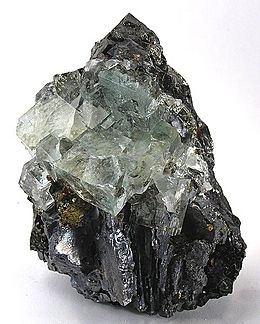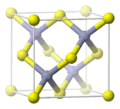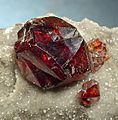Sphalerite facts for kids
Quick facts for kids Sphalerite |
|
|---|---|
 |
|
| General | |
| Category | Sulfide mineral |
| Formula (repeating unit) |
(Zn,Fe)S |
| Strunz classification | 2.CB.05a |
| Dana classification | 02.08.02.01 |
| Crystal symmetry | F43m (No. 216) |
| Unit cell | a = 5.406 Å; Z = 4 |
| Identification | |
| Color | Brown, yellow, red, green, black. |
| Crystal habit | Euhedral crystals – occurs as well-formed crystals showing good external form. Granular – generally occurs as anhedral to subhedral crystals in matrix. |
| Crystal system | Cubic |
| Twinning | Simple contact twins or complex lamellar forms, twin axis [111] |
| Cleavage | perfect |
| Fracture | Uneven to conchoidal |
| Mohs scale hardness | 3.5-4 |
| Luster | Adamantine, resinous, greasy |
| Streak | brownish white, pale yellow |
| Diaphaneity | Transparent to translucent, opaque when iron-rich |
| Specific gravity | 3.9–4.2 |
| Optical properties | Isotropic |
| Refractive index | nα = 2.369 |
| Other characteristics | non-radioactive, non-magnetic, fluorescent and triboluminescent. |
Sphalerite is a mineral. Its is a mixed zinc and iron sulfide. The chemical formula is (Zn,Fe)S. It can be brown, yellow, red, green, and black. It is normally found with galena, a lead ore. It is also known as zinc blende. It has a Mohs hardness of 3.5 to 4. It is the main ore of zinc. It has a non-metalic sheen.
Localities
The top producers of sphalerite include the United States, Russia, Mexico, Germany, Australia, Canada, China, Ireland, Peru, Kazakhstan and England.
Sources of high quality crystals include:
| Place | Country |
|---|---|
| Freiberg, Saxony, Neudorf, Harz Mountains |
Germany |
| Lengenbach Quarry, Binntal, Valais | Switzerland |
| Horni Slavkov and Příbram | Czech Republic |
| Rodna | Romania |
| Madan, Smolyan Province, Rhodope Mountains | Bulgaria |
| Aliva mine, Picos de Europa Mountains, Cantabria [Santander] Province | Spain |
| Alston Moor, Cumbria | England |
| Dalnegorsk, Primorskiy Kray | Russia |
| Watson Lake, Yukon Territory | Canada |
| Flin Flon, Manitoba | Canada |
| Tri-State district including deposits near Baxter Springs, Cherokee County, Kansas; Joplin, Jasper County, Missouri and Picher, Ottawa County, Oklahoma |
USA |
| Elmwood mine, near Carthage, Smith County, Tennessee | USA |
| Eagle mine, Gilman district, Eagle County, Colorado | USA |
| Santa Eulalia, Chihuahua | Mexico |
| Naica, Chihuahua | Mexico |
| Cananea, Sonora | Mexico |
| Huaron | Peru |
| Casapalca | Peru |
| Huancavelica | Peru |
| Zinkgruvan | Sweden |
Uses
Metal ore
Sphalerite is an important ore of zinc; around 95% of all primary zinc is extracted from sphalerite ore. However, due to its variable trace element content, sphalerite is also an important source of several other metals such as cadmium, gallium, germanium, and indium which replace zinc. The ore was originally called blende by miners (from German blind or deceiving) because it resembles galena but yields no lead.
Brass and bronze
The zinc in sphalerite is used to produce brass, an alloy of copper with 3–45% zinc. Major element alloy compositions of brass objects provide evidence that sphalerite was being used to produce brass by the Islamic as far back as the medieval ages between the 7th and 16th century CE. Sphalerite may have also been used during the cementation process of brass in Northern China during the 12th–13th century CE (Jin Dynasty). Similarly to brass, the zinc in sphalerite can also be used to produce certain types of bronze; bronze is dominantly copper which is alloyed with other metals such as tin, zinc, lead, nickel, iron and arsenic.
Other
- Yule Marble – sphalerite is found as intrusions in yule marble, which is used as a building material for the Lincoln Memorial and Tomb of the Unknown.
- Galvanized iron – zinc from sphalerite is used as a protective coating to prevent corrosion and rusting; it is used on power transmission towers, nails and automobiles.
- Batteries
- Gemstone
Images for kids
See also
 In Spanish: Esfalerita para niños
In Spanish: Esfalerita para niños





